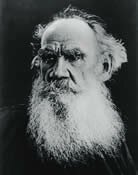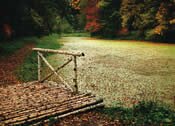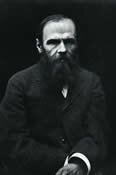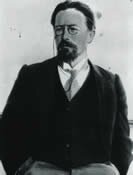Inflight Magazine of Brussels Airlines
Welcome to the Inflight Magazine of Brussels Airlines
From Russia with words
Image Getty Images
On the centenary of Leo Tolstoy’s death, Adrian Mourby remembers the great 19th-century writer – and his contemporaries Chekhov and Dostoyevsky – with a literary tour of Moscow
 Born in 1828, the author of War and Peace came from a celebrated family of aristocrats; the ‘Wild Tolstoys’ were renowned as soldiers, politicians and artists in Tsarist Russia. In some ways, Count Lev Nikolayevich Tolstoy fulfilled all these roles during his lifetime, making a huge journey from hedonistic soldier in the Crimean War, to feted author, to mystic philosopher whose ideas influenced Gandhi and Martin Luther King Jr. Now, a hundred years after his death, his work is still regarded in his homeland as ‘our Russian conscience exposed in literature’.
Born in 1828, the author of War and Peace came from a celebrated family of aristocrats; the ‘Wild Tolstoys’ were renowned as soldiers, politicians and artists in Tsarist Russia. In some ways, Count Lev Nikolayevich Tolstoy fulfilled all these roles during his lifetime, making a huge journey from hedonistic soldier in the Crimean War, to feted author, to mystic philosopher whose ideas influenced Gandhi and Martin Luther King Jr. Now, a hundred years after his death, his work is still regarded in his homeland as ‘our Russian conscience exposed in literature’.
Aristocratic author
Much of Tolstoy’s life was spent in Moscow and on his country estate. For a few years after leaving the army he was itinerant, visiting Paris and Brussels, but in 1862 he married Sofia Andreyevna Behrs, daughter of a prominent Moscow physician. The couple settled on his family estate at Yasnaya Polyana, about 240km south of Moscow, and Tolstoy immediately began to write War and Peace, his masterpiece of historical fiction, which was published in its final form in 1869. In 1882 the Tolstoys bought a home in the Khamovniki district of Moscow, because Sofia was tired of provincial life and worried that their children’s education was suffering in the countryside. This is where the family spent their winters, with Sofia attending Moscow’s season of parties while her husband grew more and more reclusive. In 1910, at the age of 82, Tolstoy left home, intending to renounce all his wealth and live as an ascetic (events featured in the recent film The Last Station, starring Christopher Plummer as Tolstoy and Helen Mirren as Sofia). He died of pneumonia at the railway station in Astapovo before he could put his plans into effect.
 Now known as the Tolstoy Estate Museum (one of the two Tolstoy museums in the city), the Tolstoy’s Moscow residence stands on Ulitsa Lva Tolstovo, two blocks away from the magnificent five-domed Church of Nikolai, with its remarkable tented bell-tower. Visitors to this gracious two-storey house have access to the children’s bedrooms, the servants’ quarters and the dining room, complete with its English china. The house is full of portraits of the family, including Tolstoy’s artistic daughter, Tatyana, painted by Ilya Repin, and Sofia painted by Valentin Serov. Tolstoy’s study is a gloomy room with dark furniture. It was here that he wrote his novella The Death of Ivan Ilyich, the moral treatises ‘On Life’ and ‘What Then Must We Do?’, and his famous denunciation of Shakespeare as a poor dramatist. In the first floor salon, meanwhile, the writer entertained eminent Russians such as the composers Rimsky-Korsakov and Rachmaninov, and writers Anton Chekhov and Maxim Gorky.
Now known as the Tolstoy Estate Museum (one of the two Tolstoy museums in the city), the Tolstoy’s Moscow residence stands on Ulitsa Lva Tolstovo, two blocks away from the magnificent five-domed Church of Nikolai, with its remarkable tented bell-tower. Visitors to this gracious two-storey house have access to the children’s bedrooms, the servants’ quarters and the dining room, complete with its English china. The house is full of portraits of the family, including Tolstoy’s artistic daughter, Tatyana, painted by Ilya Repin, and Sofia painted by Valentin Serov. Tolstoy’s study is a gloomy room with dark furniture. It was here that he wrote his novella The Death of Ivan Ilyich, the moral treatises ‘On Life’ and ‘What Then Must We Do?’, and his famous denunciation of Shakespeare as a poor dramatist. In the first floor salon, meanwhile, the writer entertained eminent Russians such as the composers Rimsky-Korsakov and Rachmaninov, and writers Anton Chekhov and Maxim Gorky.
Playwright of the people
 Standing in the salon at Ulitsa Lva Tolstovo, it’s remarkable to think that one of the finest playwrights of the 19th century sat here listening to a white-bearded, increasingly eccentric sage. Chekhov, whose 150th anniversary is celebrated this year, was 32 years younger than Tolstoy, and his background couldn’t have been more different.
Standing in the salon at Ulitsa Lva Tolstovo, it’s remarkable to think that one of the finest playwrights of the 19th century sat here listening to a white-bearded, increasingly eccentric sage. Chekhov, whose 150th anniversary is celebrated this year, was 32 years younger than Tolstoy, and his background couldn’t have been more different.
Born into a family of serfs, he arrived in Moscow in 1879 to enrol in the medical faculty of Moscow State University. Once qualified as a doctor, he supplemented his income with freelance journalism and the writing of 1,000-word comic sketches, which he was able to turn into a minor art form. Chekhov’s first play, Ivanov, premiered in 1887 at the Korsh Theatre in Moscow, but he didn’t like the production. His second work, The Seagull, was a worse disaster when it opened in St Petersburg in October 1896 – in fact, the booing of the audience almost convinced the writer to renounce theatre. Fortunately, a radical director called Constantin Stanislavski restaged the play at the Moscow Art Theatre two years later with a customary attention to psychological realism and ensemble playing. A fruitful partnership was then formed, which brought forth Uncle Vanya, Three Sisters and The Cherry Orchard. Chekhov wrote to Stanislavski, “You have brought my Seagull back to life.”
Located just off Tverskaya Street and within walking distance of Red Square, The Moscow Art Theatre still functions today, and has a seagull as its emblem. The small pink-painted house where Chekhov lived, meanwhile, on Ulitsa Sadovaya-Kudrinskaya, is now the Chekhov House Museum. Visitors can see the writer’s study and consulting room, the modest bedrooms, and the contrastingly ornate family salon. Much of the dining room is now devoted to an exhibition of original playbills and first editions of Chekhov’s works.
Early existentialist
 The third great writer residing in Moscow in Tolstoy’s day was Fyodor Mikhaylovich Dostoyevsky. Curiously, the two never met, even though Dostoyevsky called Anna Karenina a “flawless work of art”, and a copy of Dostoyevsky’s Brothers Karamazov was found on the nightstand next to Tolstoy’s deathbed. Dostoyevsky was born at the Mariinsky Hospital for the Poor in Moscow, where his father – a retired military surgeon with a violent alcoholic temper – had been employed.
The third great writer residing in Moscow in Tolstoy’s day was Fyodor Mikhaylovich Dostoyevsky. Curiously, the two never met, even though Dostoyevsky called Anna Karenina a “flawless work of art”, and a copy of Dostoyevsky’s Brothers Karamazov was found on the nightstand next to Tolstoy’s deathbed. Dostoyevsky was born at the Mariinsky Hospital for the Poor in Moscow, where his father – a retired military surgeon with a violent alcoholic temper – had been employed.
In the 1820s the Mariinsky was located in one of the city’s worst areas: the young Dostoyevsky’s world was bounded by the hospital, a cemetery for criminals, an orphanage for abandoned infants, and a lunatic asylum. So it was perhaps inevitable that the author of Crime and Punishment would grow up fascinated by the oppressed and tormented, and that his books would be full of psychological insights into the misery of poverty.
The family’s cramped house in the hospital grounds is now the Dostoyevsky Museum (2 Ulitsa Dostoevskovo). The interior has been reconstructed from Dostoyevsky’s descriptions of his childhood using furniture that his wife donated after the troubled writer’s death in 1881, and visitors can view the tiny room he shared with his brother. Despite a lack of space, there’s a modest drawing room – essential for the family’s social standing in Moscow – while Dostoyevsky’s parents slept in a narrow bed jammed between a screen and a washstand. The museum proudly displays the writer’s quill pen and his autograph, and the walls are decorated with family portraits and engravings, which show what Moscow looked like in the days when these three literary giants strode the city.
Write on…
21st-century Russian scribes
As the political landscape of Russia changed, the successors to Tolstoy, Chekhov and Dostoyevsky recorded a very different world. The work of writers such as Alexander Solzhenitsyn, Vasily Aksyonov and Grigory Baklanov dealt with the Soviet era, the Great Patriotic War and life under totalitarianism. Sadly, all three men passed away in the last two years.
Prominent amongst those writing in Russia today are Daniil Granin (b.1919), Vladimir Voinovich (b.1932) Lyudmila Ulitskaya (b.1943) and Dina Rubina (b.1953). While the west champions young novelists who reflect the changing fashions of contemporary society, Russian literature remains a world of serious talent honed over many years.
FR Bons mots de Russie
À l’occasion du centenaire de la mort de Léon Tolstoï, Adrian Mourby part sur les traces du grand écrivain du 19ème siècle et de ses contemporains dans un tour littéraire de Moscou.
Le Comte Lev Nikolaïevitch Tolstoï naît en 1828 dans une famille d’aristocrates. Il sert dans l’armée durant la Guerre de Crimée et après quelques séjours à Paris et à Bruxelles, il épouse Sofia Andreyevna Behrs en 1862. Le couple s’installe sur une propriété familiale située à Yasnaya Polyana, où Tolstoï écrira Guerre et Paix. En outre, les Tolstoï disposent d’une maison à Moscou. C’est cette résidence moscovite sur l’avenue Ulitsa Lva Tolstovo qui deviendra l’actuel Musée Tolstoï. Aujourd’hui, les visiteurs peuvent y découvrir de nombreux portraits de famille ainsi que le bureau du fameux écrivain ; c’est ici qu’il rédigea la nouvelle La Mort d’Ivan Ilyich ainsi que ses écrits critiques sur Shakespeare. Au premier étage, on peut voir le salon où il reçut de nombreux artistes, dont Anton Tchekhov, de 32 ans son cadet.
Tchekhov naît dans une famille de serfs et il se rend à Moscou pour étudier la médecine. Sa première pièce de théâtre, Ivanov, est produite en 1887 au Théâtre Korsh, mais l’auteur n’apprécie pas la mise en scène. La Mouette est à son tour mal accueillie par le public. Fort heureusement, la rencontre de l’écrivain avec Constantin Stanislavski, directeur du Théâtre d’Art de Moscou, permet de proposer une nouvelle approche dramaturgique, plus radicale. Sous l’impulsion d’une nouvelle mise en scène, le succès est au rendezvous et marque le début d’une longue relation fructueuse. À quelques pas seulement de la Place Rouge, le Théâtre d’Art de Moscou est resté l’une des importantes institutions de la scène culturelle, et la maison où vécut Tchekhov, dans la rue Ulitsa Sadovaya-Kudrinskaya, a été transformée en Musée.
Fedor Mikhaïlovitch Dostoïevski est le troisième grand écrivain moscovite de l’époque. Né à l’Hôpital Mariinsky de Moscou, dit l’hôpital des Pauvres, le parcours de l’auteur de Crime et Châtiment a été jalonné par l’hôpital, l’orphelinat et l’asile – ce qui explique sans doute pourquoi ses livres sont inévitablement imprégnés d’incursions dans les profondeurs de l’esprit et dans le monde de la misère. L’exiguë maison familiale située au 2 Ulitsa Dostoevskovo est désormais un musée, elle fut reconstruite à partir des descriptions de Dostoïevski sur son enfance. Aux murs sont suspendus des portraits et des gravures montrant le Moscou de l’époque, celle où ces géants de la littérature arpentaient les rues.
NL From Russia with words
Adrian Mourby brengt op het eeuwfeest van het overlijden van Leo Tolstoj een ode aan de grootse 19e-eeuwse schrijver en zijn tijdgenoten, in een literaire rondleiding van Moskou.
Graaf Lev Nikolajevitsj Tolstoj werd geboren in 1828. Hij behoorde tot een familie van aristocraten. Hij vocht mee in de Krimoorlog, woonde in Parijs en Brussel, en trouwde in 1862 met Sofia Andreyevna Behrs. Ze vestigden zich op het landgoed van zijn familie in Yasnaya Polyana, waar Tolstoj Oorlog en Vrede schreef, en ze hadden ook een verblijfplaats in Moskou. In dat huis in de Ulitsa Lva Tolstovo is nu het Tolstoy Estate Museum ingericht. Naast tal van familieportretten kunnen de bezoekers er ook Tolstoj’s werkkamer bewonderen – waar hij de roman De Dood van Ivan Ilyich en zijn beroemde bespotting van Shakespeare schreef – en het salon op de eerste verdieping waar hij heel wat kunstenaars ontving, waaronder Anton Chekhov.
Chekhov was 32 jaar jonger dan Tolstoj. Hij was een zoon van Servische ouders en verhuisde naar Moskou om er dokter te worden. Zijn eerste toneelstuk Ivanov ging in 1887 in première in het Korsh Theatre, maar hij hield niet van het stuk. Ook De Meeuw werd een flop. Gelukkig hernam de radicale regisseur Constantin Stanislavski het stuk in het Moscow Art Theatre. Het overweldigende succes mondde uit in een vruchtbaar partnerschap.
Op een boogscheut van het Rode Plein is het Moscow Art Theatre vandaag nog steeds actief. Het huis in Ulitsa Sadovaya-Kudrinskaya waarin Chekhov leefde, is nu het Chekhov Museum.
De derde grote schrijver in Moskou in die tijd was Fjodor Michajlovitsj Dostojevski. De schrijver van het meesterwerk Misdaad en Straf werd geboren in het Marinski-ziekenhuis voor de Armen in Moskou en was voor altijd verbonden met het ziekenhuis, een weeshuis en een tehuis. Het was dan ook wellicht onvermijdelijk dat een psychologische inkijk op miserie en armoede een terugkerend thema zou worden in zijn werken. Het kleine huis van de familie Dostojevski in de Ulitsa Dostoevskovo 2 is nu een museum dat ingericht is volgens Dostojevski’s beschrijvingen van zijn eigen jeugd. De muren zijn er versierd met portretten en gravures die een goed beeld geven van hoe Moskou er uitzag ten tijde van de literaire grootmeesters.
Leave a Reply
